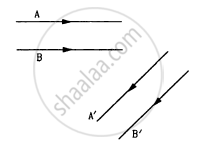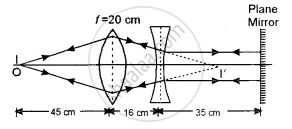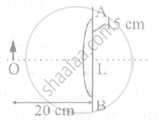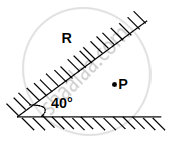Advertisements
Advertisements
प्रश्न
following Figure shows two rays A and B being reflected by a mirror and going as A' and B'. The mirror
पर्याय
is plane
is convex
is concave
may be any spherical mirror.
उत्तर
is plane
This is because the reflected rays are still parallel, which is only possible if the mirror is a plane mirror. A spherical mirror will either converge or diverge the reflected rays.
APPEARS IN
संबंधित प्रश्न
a) Give two reasons to explain why reflecting telescopes are preferred over refracting type.
Use the mirror equation to deduce that an object placed between the pole and focus of a concave mirror produces a virtual and enlarged image.
Using mirror formula, explain why does a convex mirror always produce a virtual image.
Use the mirror equation to show a convex mirror always produces a virtual image independent of the location of the object ?
A point source of light is placed in front of a plane mirror.
The rays of different colours fail to converge at a point after going through a converging lens. This defect is called
A cylindrical vessel of diameter 12 cm contains 800π cm3 of water. A cylindrical glass piece of diameter 8.0 cm and height 8.0 cm is placed in the vessel. If the bottom of the vessel under the glass piece is seen by the paraxial rays (see figure), locate its image. The index of refraction of glass is 1.50 and that of water is 1.33.

A light ray is incident at an angle of 45° with the normal to a √2 cm thick plate (μ = 2.0). Find the shift in the path of the light as it emerges out from the plate.
Write any one use for each of the following mirrors :
(a) Convex
(b) Concave
The figure below shows the positions of a point object O, two lenses, a plane mirror and the final image I which coincides with the object. The focal length of the convex lens is 20 cm. Calculate the focal length of the concave lens.

For paraxial rays, show that the focal length of a spherical mirror is one-half of its radius of curvature.
A point object is placed at a distance of 20 cm from a thin plano-convex lens of focal length 15 cm, if the plane surface is silvered. The image will form at:

A parallel beam of light is allowed to fall on a transparent spherical globe of diameter 30cm and refractive index 1.5. The distance from the centre of the globe at which the beam of light can converge is ______ mm.
Car B overtakes car A at a relative speed of 40 ms-1. How fast will the image of car B appear to move in the mirror of focal length 10 cm fitted in car A, when car B is 1.9 m away from car A?
An upright object is placed at a distance of 40 cm in front of a convergent lens of a focal length of 20 cm. A convergent mirror of focal length 10 cm is placed at a distance of 60 cm on the other side of the lens. The position and size of the final image will be ______.
Two plane mirrors are inclined at an angle of 40°. The possible number of images of an object placed at point P would be?

